How to Get Rid Of Moles
49 min read Updated for November, 2019
These underground dwellers are not as visible as other pests, but they can be very destructive. Moles spend a majority of their time digging large, elaborate tunnels that can undermine building foundations and produce unsightly mole “hills” and raised ridges in your yard.
49 min read Updated for November, 2019

Mole Sounds
Moles do communicate and ‘chatter’ with each other through chirps, snorts, guttural noises, and high-pitched squeals. Some mole species also are known to wheeze.
Mole Tracks
Since moles live underground and navigate through underground tunnel passages, it’s very rare to see their tracks. Their feet are quiet large in proportion to their bodies and their front paws are considerably wide, which aids in their digging, and the hind paws are somewhat smaller, but both sets of feet have very sharp claws.
Mole Poop
Again, living most of their life undergrounds, mole poop above ground is not that common. When found it is identified as pieces of small brown pellets.
Identify
Moles are not as similar to other burrowers than you might expect. Instead of feeding on roots and tubers like gophers, or relying on herbs like groundhogs, these strange-looking creatures eat insects. For this reason, moles are actually not classified as rodents, but belong to a group of shrew-like creatures called insectivores.
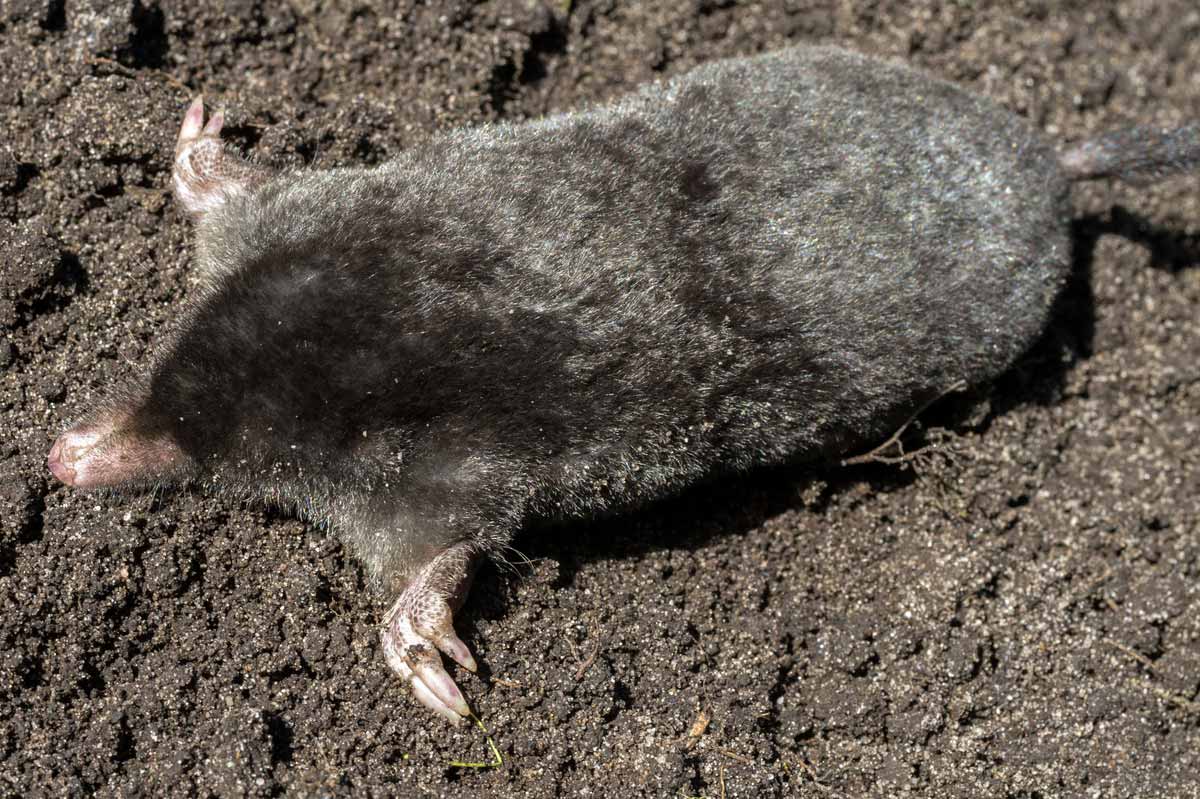
Physical Characteristics
Moles are among the strangest-looking small mammals you’ll meet. Because they’ve evolved to spend almost all of their time underground, they’ve developed highly distinctive features.
Color:
Moles can be brown, grey, or black with pink paws.
Tail:
Mole tails are very short; you might think moles are tail-less at first glance.
Teeth:
Moles have small, needle-like teeth that are not visible when their mouths are closed (unlike gophers).
Size:
Moles are smaller than some other burrowers; they reach between four to seven inches in length and weigh up to 20 ounces.
Eyes:
Since they spent most of their time in the dark, moles have small, sometimes fur-covered eyes and poor vision.
Limbs:
Moles feature oversized, hairless paws with claws that help them dig; their forelimbs are exceptionally large and hand-like.
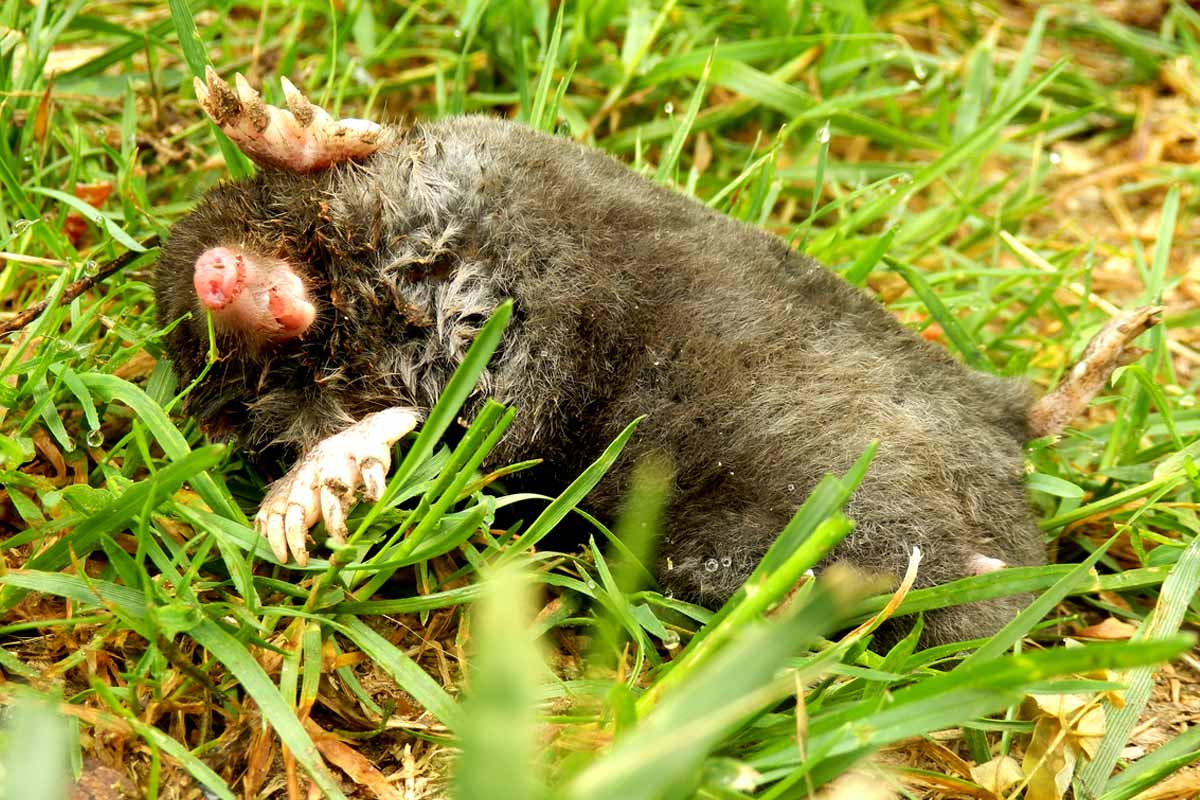
Treating Your Property For Moles
As you’ve probably gathered by now, moles aren’t the easiest animal to trap. If you’re not up to the task of digging up a tunnel and using a trap, then you might want to try these easier treatment methods first.
DIY Treatments
Getting rid of moles doesn’t need to cost a lot of money. In fact, many household items can help prevent and scare off moles, and you probably already own them. Here are some DIY treatment ideas to get you started.
Castor Oil
Most rodents detest the smell of castor oil, which makes it an excellent all-purpose repellent. You can pour castor oil around or into their burrows or create a solution by adding water, which can then be used to spray in the garden.
Eucalyptus Oil
This strong-smelling oil may be soothing to humans, but moles will find it unsettling if they detect it in their burrows. Try oiling some cotton balls and then placing them wherever you see a tunnel entrance.
Pet Waste
Has your dog or cat ever presented you with a dead mole? That’s because domestic pets are their natural predators. For this reason, some well-placed pet droppings, which the moles will smell immediately, may be enough to scare the moles away from your property.
Coffee Grinds
Coffee grinds are another good way to turn the mole’s keen sense of smell against it. Adding the grinds to their burrows can overwhelm their sensitive noses and cause them to flee.
Mole Problem?
Moles don’t need as much oxygen as other animals and can even recycle the air they breathe.
Behavior
Moles can dig tunnels at an alarming rate—almost one foot per minute—which make them a threat for many landowners. Here’s what to know about their behavior if you’re encountering a mole problem.
- While many confuse them with rodents, who often eat plants, moles eat only insects.
- About 80% of their calories come from earthworms.
- Mole saliva contains a chemical that paralyzes the worms moles attack, making them easier to eat.
- Moles can store many of these paralyzed, half-eaten worms in their burrows.
- Moles are solitary except in the spring when they mate.
- Mole litters contain three or four offspring.
- Baby moles venture off on their own at about five or six weeks.
- While they dig shallow tunnels to hunt for worms, they also have deeper tunnels to use during cold weather.
- Males can eat almost their entire body weight of insects in one day.
- Moles don’t need as much oxygen as other animals and can even recycle the air they breathe.
Dozens of species have evolved to suit their different homes.
Habitat
Moles are highly adaptable creatures that can live in a range of different landscapes. Climate preference will also depend heavily on the species of mole, but here are some general guidelines for habitats where moles will likely live.
- Areas where the soil is easy to dig in but still firm enough to support burrow structures.
- Locations where plenty of insects are available to feed on.
- Meadows, grasslands, plains, and wetlands; some species can even live in desserts.
- Suburban environments with an adequate food supply.
Geography
Because they’re so versatile, moles can survive in many different areas of the world. In fact, dozens of species have evolved to suit their different homes.
- Moles occupy much of the Eastern United States and extend as far North as Canada.
- They can also occupy parts of the West Coast.
- Asia and Europe have their own common species of moles.
Common Species
Here are a few of the most common species of moles and how to identify them.

Eastern Mole
One of the most widespread and recognizable species, this common creature is what people think of when they picture a mole.
Appearance
- Long snout extends far beyond the mouth
- Spade-like, clawed paws make them efficient diggers
- Usually grey-brown with a lighter underside
Behavior
- Builds both shallow and deep tunnels for foraging and nesting, respectively
- Primarily eats earthworms but will consume other insects if available
- Active at all hours of the day and night, with breaks for resting
- Lines its underground nests with dried plants

Star-Nosed Mole
If you happen to spot one of these moles on your property, you’ll have no trouble identifying it. The star-nosed mole’s unique snout makes it stand out from all other species.
Appearance
- Known for its unusual star-shaped snout
- Can be mottled or dark brown
- Longer tail than eastern moles
Behavior
- Have adapted to live in swampy, poorly drained areas and near water
- Good swimmers
- May eat amphibians, water insects, small fish, as well as other insects

American Shrew Mole
This type of mole shares characteristics with both shrews and moles, hence the name. It is the smallest of all mole species.
Appearance
- Only reaches four inches in length
- Fur is dark gray or black
- Small eyes that are completely covered by skin
Behavior
- Found exclusively in the Northwestern corner of the U.S.
- Often chooses to tunnel in the abandoned tunnels of other burrowers
- Prefers damp soil near water sources

Hairy-Tailed Mole
This type of mole occupies the Northeastern area of the U.S., extending into the Southeastern corner of Canada.
Appearance
- Grey fur with a lighter underbelly
- A medium-sized mole at five to six inches in length and two ounces in weight
- Tail features more fur than most mole species
Behavior
- Frequently forages above ground at night
- Prefers damp soil that is easy to excavate
- Primarily eats larvae and worms
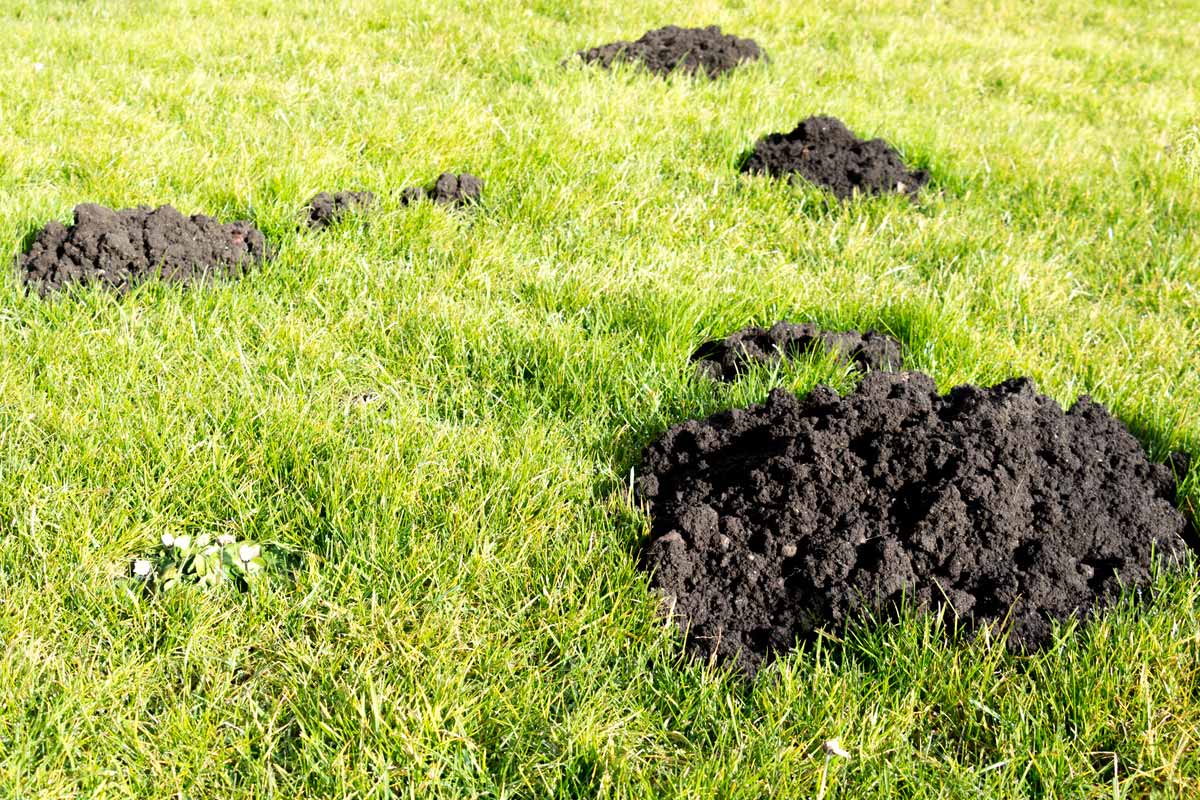
Common Locations
Moles can thrive in many different types of habitats. Some species of moles live in arid climates while others prefer swamps. The most common mole species, the Eastern mole, looks for a habitat that’s somewhere in between—not too wet and not too dry. Overall, moles tend to like woodlands, orchards, open fields, and even suburban areas and golf courses. They avoid heavy clay and gravelly terrain.
Moles species have adapted to survive in many different climates.
Why They’re There
If you’ve spotted the tell-tale signs of moles in your yard, like long raised ridges and “hills,” you may be wondering what drew them there in the first place. Here are a few features that moles look for when making a home.
Food
Despite what many people think, moles are not rodents. They only feed on insects, mainly earthworms and larvae, although some species branch out to other plant matter if they have no other option. So if you see a lot of moles, you may have an abundance of earthworms. Earthworms eat dead plant matter, so you may be seeing more of them if you have lots of plants in your yard.
Landscape
As we mentioned earlier, moles species have adapted to survive in many different climates. However, the majority of moles will look for well-aerated soil that is not too dry and not too rocky. If you have this type of soil, you may encounter more moles.
Water
Most moles like damp soil that doesn’t dry out, so you see more of them if you live in an area with plenty of rainfall. Specific types of moles, like the star-nosed mole, will gravitate toward swampy or poorly drained landscapes.
Mole Sounds
Moles do communicate and ‘chatter’ with each other through chirps, snorts, guttural noises, and high-pitched squeals. Some mole species also are known to wheeze.
Mole Tracks
Since moles live underground and navigate through underground tunnel passages, it’s very rare to see their tracks. Their feet are quiet large in proportion to their bodies and their front paws are considerably wide, which aids in their digging, and the hind paws are somewhat smaller, but both sets of feet have very sharp claws.
Mole Poop
Again, living most of their life undergrounds, mole poop above ground is not that common. When found it is identified as pieces of small brown pellets.
Inspect
Moles very rarely surface from their underground tunnels, so it’s more time-effective to look for the signs of moles rather than the reclusive critters themselves. These signs can include deposits of dirt called “molehills,” or raised ridges of soil, especially along a wall or sidewalk. Pay close attention to any uneven ground that seems to sink when you step on it.
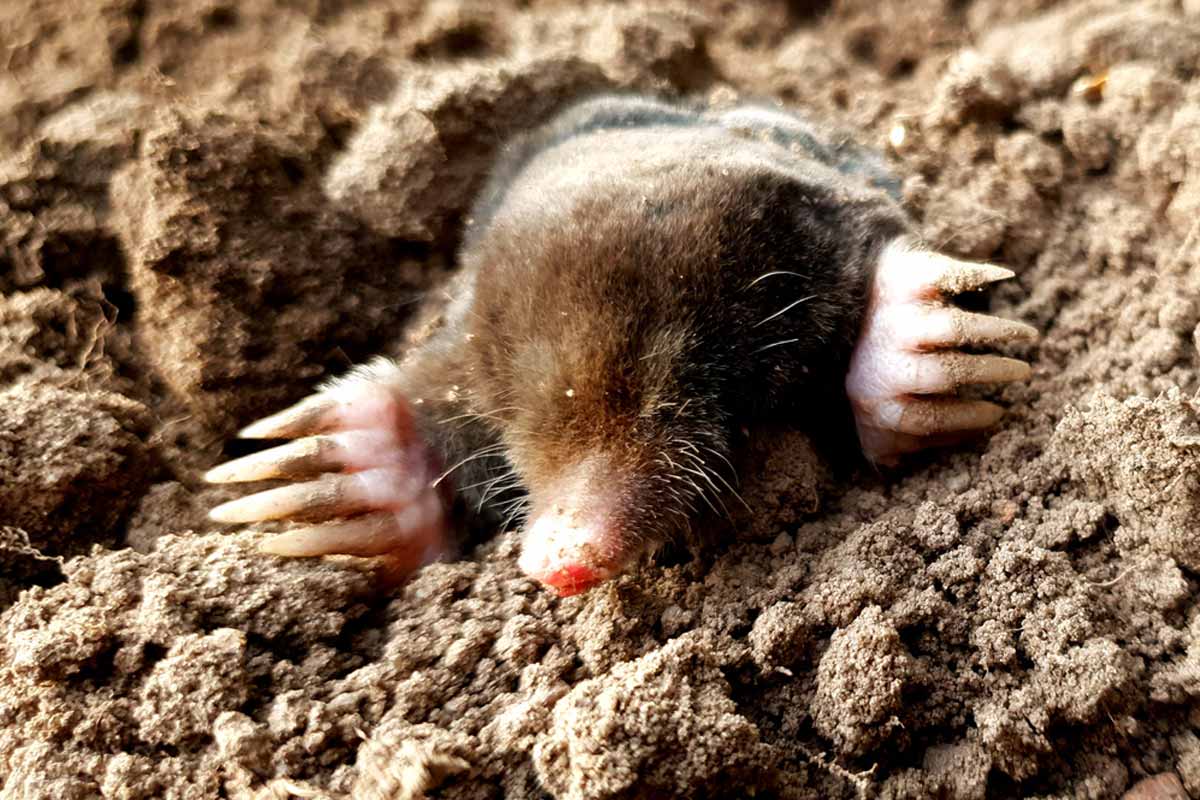
Should I Relocate This Animal?
Just how big a problem are moles? It all depends on how much they’ve damaged your property. If you value a pristine yard, getting rid of the moles may help you avoid molehills, ridges, and tripping hazards. What’s more, if you suspect that they may have excavated under the foundation of your home, it may be worthwhile to trap and relocate the animals.
Risk Of Disease Or Injury
Moles are among the least intimidating small mammals out there, thanks to their skittish demeanor and tiny teeth. They are unlikely to cause any harm to humans who try to catch them. However, the parasites that they carry may put humans at risk of contracting a disease indirectly if they handle a mole.
Cost
Live-trapping a mole may involve purchasing some equipment. However, protecting your home or garden from moles may help you save money in the long run.
Ecological Benefits
Moles don’t benefit humans in any direct way. However, they can help keep your ecosystem in equilibrium by managing pest insect populations, aerating the soil, and providing a home for other small animals.
Time
Because they so seldom leave their underground burrows, moles can be tricky to catch. If you plan on catching the animals yourself, know that some degree of trial and error is normal. If you don’t have time for several attempts, it may be worth hiring a professional at the outset.

Treating Your Property For Moles
As you’ve probably gathered by now, moles aren’t the easiest animal to trap. If you’re not up to the task of digging up a tunnel and using a trap, then you might want to try these easier treatment methods first.
DIY Treatments
Getting rid of moles doesn’t need to cost a lot of money. In fact, many household items can help prevent and scare off moles, and you probably already own them. Here are some DIY treatment ideas to get you started.
Castor Oil
Most rodents detest the smell of castor oil, which makes it an excellent all-purpose repellent. You can pour castor oil around or into their burrows or create a solution by adding water, which can then be used to spray in the garden.
Eucalyptus Oil
This strong-smelling oil may be soothing to humans, but moles will find it unsettling if they detect it in their burrows. Try oiling some cotton balls and then placing them wherever you see a tunnel entrance.
Pet Waste
Has your dog or cat ever presented you with a dead mole? That’s because domestic pets are their natural predators. For this reason, some well-placed pet droppings, which the moles will smell immediately, may be enough to scare the moles away from your property.
Coffee Grinds
Coffee grinds are another good way to turn the mole’s keen sense of smell against it. Adding the grinds to their burrows can overwhelm their sensitive noses and cause them to flee.
Mole Problem?
Since moles stay underground, you’ll need to place the trap inside the tunnel.
Gather The Tools You’ll Need
Leather Gloves
Helps disguise your scent when you’re planting the trap and protects your hands from mole parasites that may carry diseases.
A Live-Catch Trap
Some experts recommend buying a plastic tube trap, which has a swing door on each side so that moles can enter but won’t be able to exit.
Shovel
Since moles stay underground, you’ll need to place the trap inside the tunnel. This will require digging to find and expand the tunnel.
A Two-Gallon Bucket
If you prefer not to buy a trap, you may be able to use a plastic bucket buried at the level of the mole’s runway.
Tarp
Protects your vehicle from animal waste during transport.
Blanket
Can be placed on top of the trap during transport to calm the scared animal.
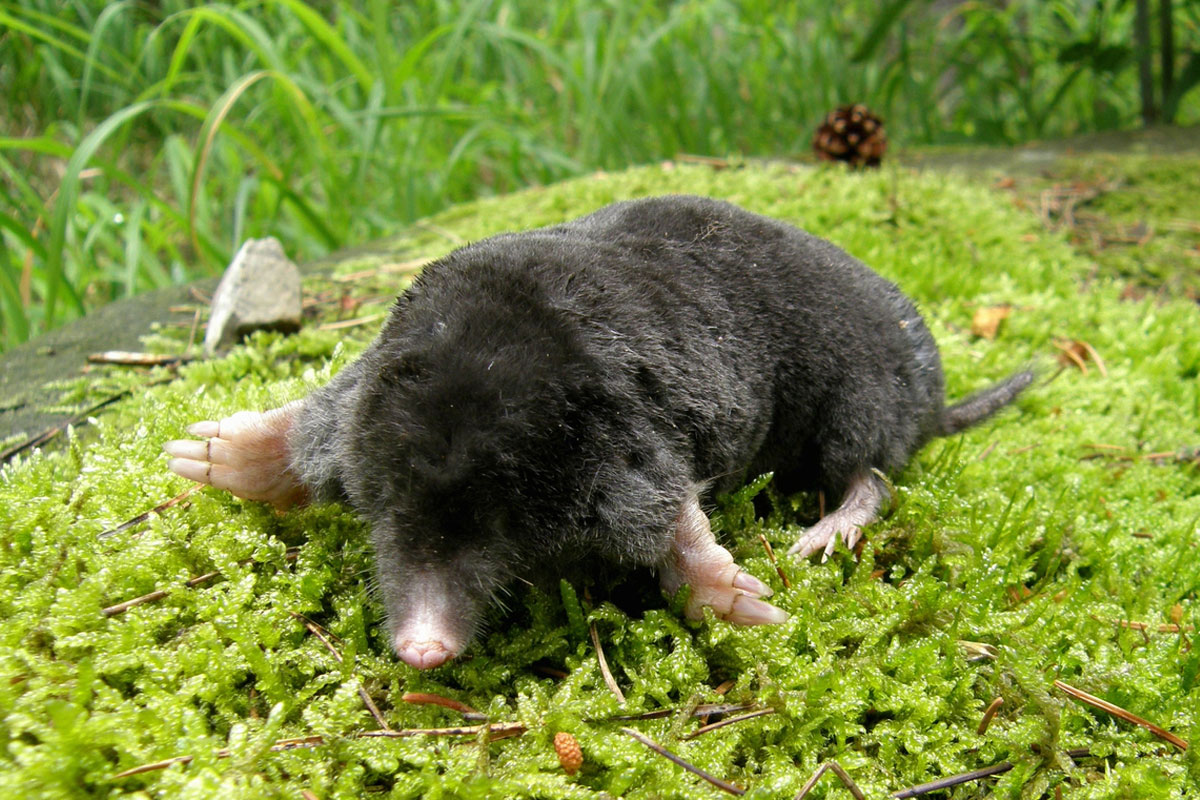
Moles can’t see much, but they are sensitive to light.
How-To Steps for DIY Removal
There are a couple of different methods you can use to catch your mole. The first involves buying a tube trap that sits at the level of the mole runway and captures them when they attempt to walk through. The second uses a bucket buried bucket to accomplish the same goal.
Using A Tunnel Trap
Step 1: First you need to identify an active burrow. Moles usually leave visible signs of their tunnels in the form of raised ridges or dirt deposits. Try to find a fresh one; you may be more likely to find a new one after there’s been a hard rain and the soil is soft and easy to excavate.
Step 2: Dig into the tunnel chamber. You’ll need to expand the tunnel chamber so that it’s wide enough to fit the trap.
Step 3: Place the trap. You will want to place the tube trap along the length of the tunnel so that it’s level with the rest of the mole’s runway.
Step 4: Cover the trap. Moles can’t see much, but they are sensitive to light. Try to re-cover the tunnel’s ceiling after you’ve placed the trap. You can use a board or tarp, so you don’t have to re-cover with soil.
Step 5: Check the trap. Mole burrows can be elaborate, with many different passageways, so it may take a few days for the mole to pass through your trap. Or you may need to experiment with placing the trap in different areas of your yard.
Step 6: Relocate. Make sure you’ve received permission from the new land’s owner before releasing. In some states, moles are considered a nuisance animal, and you are not legally allowed to relocate them to someone else’s property without obtaining approval.
Trapping with a bucket
While this method’s not quite as precise as using a real trap, it may save you some money and a trip to the store. Here’s how to use a bucket to capture your mole.
Step 1-3: Follow the steps for using a tube trap.
Step 4: Place the top of the bucket at the same level as the mole’s tunnel, so that it will fall in when trying to cross.
Step 5-6: Follow the steps for using a tube trap.

It’s possible for moles to be rabid, although due to their small mouths and reclusive demeanor, it’s extremely rare for them to infect humans.
Risks Of Disease
Lyme disease:
Like many other mammals, moles can get ticks, which can then be passed on to pets or humans. These ticks may carry Lyme disease, which can be a serious illness when not caught early. Keep an eye out for a rash as well as other symptoms like fever, fatigue, and swollen lymph nodes.
Tularemia:
Handling an infected mole can cause this bacterial infection. It can also be spread by ticks, which may bite infected moles and then bite humans. Symptoms vary, but antibiotics can treat this serious disease.
Rabies:
It’s possible for moles to be rabid, although due to their small mouths and reclusive demeanor, it’s extremely rare for them to infect humans through bite wounds. Keep an eye on your pets, though, which may come into contact with moles more often than you and your family.
Mole Sounds
Moles do communicate and ‘chatter’ with each other through chirps, snorts, guttural noises, and high-pitched squeals. Some mole species also are known to wheeze.
Mole Tracks
Since moles live underground and navigate through underground tunnel passages, it’s very rare to see their tracks. Their feet are quiet large in proportion to their bodies and their front paws are considerably wide, which aids in their digging, and the hind paws are somewhat smaller, but both sets of feet have very sharp claws.
Mole Poop
Again, living most of their life undergrounds, mole poop above ground is not that common. When found it is identified as pieces of small brown pellets.
Prevent
Once you’ve removed the offending mole, it’s time to protect your yard from future infestations. Even if you’ve relocated one mole, the existing burrows may make your yard more attractive to future burrowers. Here are a few ideas for keeping your home free of moles.

Prevention Methods
- Try installing a mesh metal fence that extends at least two feet beneath the soil around your yard. Since moles are small creatures, the mesh will need to be tightly woven, with holes no bigger than half an inch.
- Moles feed on common garden insects, like larvae, earthworms, and grub. While you don’t want to rid your lawn of earthworms completely—since they help promote healthy soil—you may want to try controlling some of the less beneficial insects, like grub. You can find grub-controlling products at your local hardware or garden store.
- Moles thrive in damp soil that’s easy to dig through. Over-watering your lawn may contribute to increased mole populations, so try to use discretion, especially during the summer months.
- Moles can’t dig well in rocky terrain. Try adding rocks to the soil around your yard to prevent burrowing.
- Try flattening the abandoned tunnels. You can do this by spraying a garden hose on the burrowed areas and then tamping down the raised tunnels with your feet or a hand tamper. If you have more extensive tunnel damage you wish to fill in, consider renting a lawn roller. This can help prevent future moles—or other burrowing species—from taking up residence there.
Treating Your Property For Moles
As you’ve probably gathered by now, moles aren’t the easiest animal to trap. If you’re not up to the task of digging up a tunnel and using a trap, then you might want to try these easier treatment methods first.
DIY Treatments
Getting rid of moles doesn’t need to cost a lot of money. In fact, many household items can help prevent and scare off moles, and you probably already own them. Here are some DIY treatment ideas to get you started.
Castor Oil
Most rodents detest the smell of castor oil, which makes it an excellent all-purpose repellent. You can pour castor oil around or into their burrows or create a solution by adding water, which can then be used to spray in the garden.
Eucalyptus Oil
This strong-smelling oil may be soothing to humans, but moles will find it unsettling if they detect it in their burrows. Try oiling some cotton balls and then placing them wherever you see a tunnel entrance.
Pet Waste
Has your dog or cat ever presented you with a dead mole? That’s because domestic pets are their natural predators. For this reason, some well-placed pet droppings, which the moles will smell immediately, may be enough to scare the moles away from your property.
Coffee Grinds
Coffee grinds are another good way to turn the mole’s keen sense of smell against it. Adding the grinds to their burrows can overwhelm their sensitive noses and cause them to flee.
Mole Problem?
Mole Sounds
Moles do communicate and ‘chatter’ with each other through chirps, snorts, guttural noises, and high-pitched squeals. Some mole species also are known to wheeze.
Mole Tracks
Since moles live underground and navigate through underground tunnel passages, it’s very rare to see their tracks. Their feet are quiet large in proportion to their bodies and their front paws are considerably wide, which aids in their digging, and the hind paws are somewhat smaller, but both sets of feet have very sharp claws.
Mole Poop
Again, living most of their life undergrounds, mole poop above ground is not that common. When found it is identified as pieces of small brown pellets.
When to Call a Professional
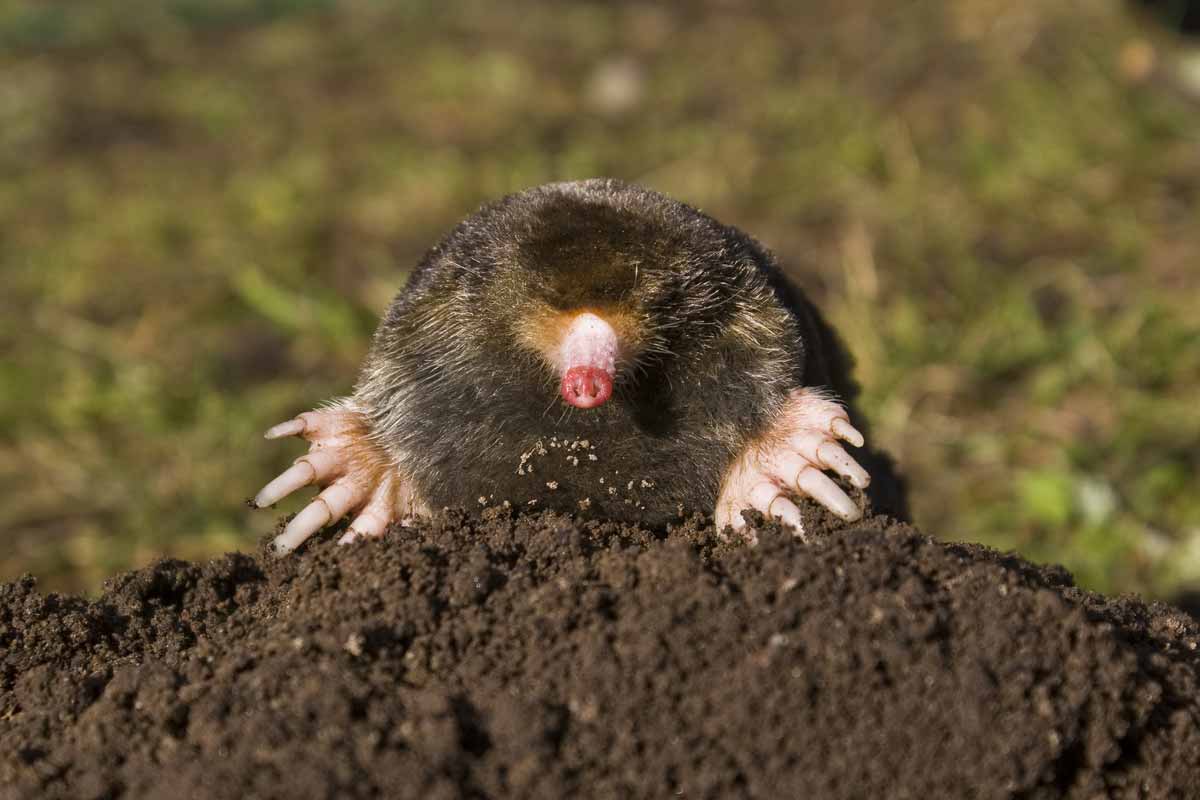
Moles can occupy the same tunnel systems for generations. Unfortunately for homeowners, this means your house or yard could be on top of an ever-expanding network of burrows that present foundation problems and cause unattractive soil deposits. If you think that your mole problem may be getting out of control, it may be time to call in a professional and reclaim your peace of mind.
Sources
https://www.yourgreenpal.com/blog/the-8-best-home-remedies-to-get-rid-of-moles-and-gophers
https://www.improvementscatalog.com/RoomForImprovements/get-rid-moles-using-home-remedies/
https://homeguides.sfgate.com/flatten-yard-after-moles-gone-30184.html
https://www.consumerreports.org/cro/news/2008/10/pest-patrol-how-to-control-moles-in-your-yard/index.htm
http://icwdm.org/handbook/mammals/Moles.asp
https://animals.mom.me/habitat-moles-2919.html
https://www.crittercontrol.com/services/moles/do-moles-carry-disease
https://en.wikipedia.org/wiki/American_shrew_mole
http://home.cc.umanitoba.ca/~campbelk/moledistribution.html
http://www.mammal.org.uk/sites/default/files/factsheets/mole_complete.pdf
https://www.columbiatribune.com/1ba4e312-1072-5597-ad87-9e7ce77d8995.html
https://www.livescience.com/52297-moles.html
Treating Your Property For Moles
As you’ve probably gathered by now, moles aren’t the easiest animal to trap. If you’re not up to the task of digging up a tunnel and using a trap, then you might want to try these easier treatment methods first.
DIY Treatments
Getting rid of moles doesn’t need to cost a lot of money. In fact, many household items can help prevent and scare off moles, and you probably already own them. Here are some DIY treatment ideas to get you started.
Castor Oil
Most rodents detest the smell of castor oil, which makes it an excellent all-purpose repellent. You can pour castor oil around or into their burrows or create a solution by adding water, which can then be used to spray in the garden.
Eucalyptus Oil
This strong-smelling oil may be soothing to humans, but moles will find it unsettling if they detect it in their burrows. Try oiling some cotton balls and then placing them wherever you see a tunnel entrance.
Pet Waste
Has your dog or cat ever presented you with a dead mole? That’s because domestic pets are their natural predators. For this reason, some well-placed pet droppings, which the moles will smell immediately, may be enough to scare the moles away from your property.
Coffee Grinds
Coffee grinds are another good way to turn the mole’s keen sense of smell against it. Adding the grinds to their burrows can overwhelm their sensitive noses and cause them to flee.
Mole Problem?
Sources
https://www.trutechinc.com/services/animal-sounds/mole/
https://www.crittercontrol.com/services/moles/mole-tracks
Mole Sounds
Moles do communicate and ‘chatter’ with each other through chirps, snorts, guttural noises, and high-pitched squeals. Some mole species also are known to wheeze.
Mole Tracks
Since moles live underground and navigate through underground tunnel passages, it’s very rare to see their tracks. Their feet are quiet large in proportion to their bodies and their front paws are considerably wide, which aids in their digging, and the hind paws are somewhat smaller, but both sets of feet have very sharp claws.
Mole Poop
Again, living most of their life undergrounds, mole poop above ground is not that common. When found it is identified as pieces of small brown pellets.





